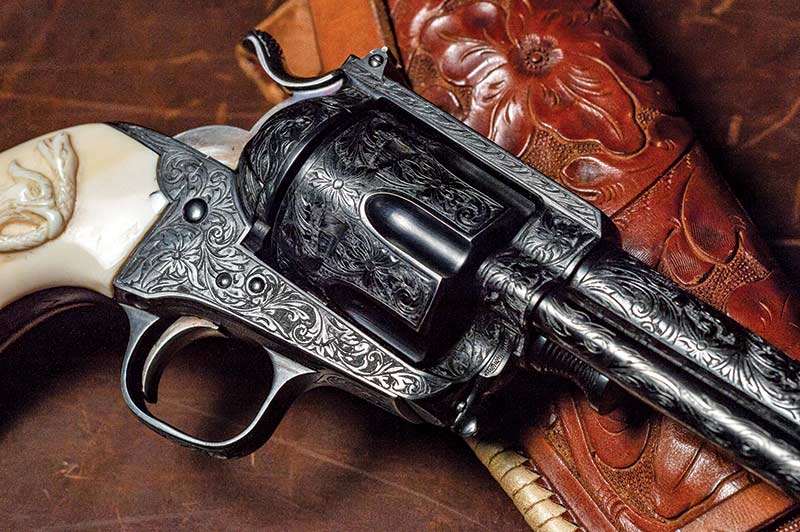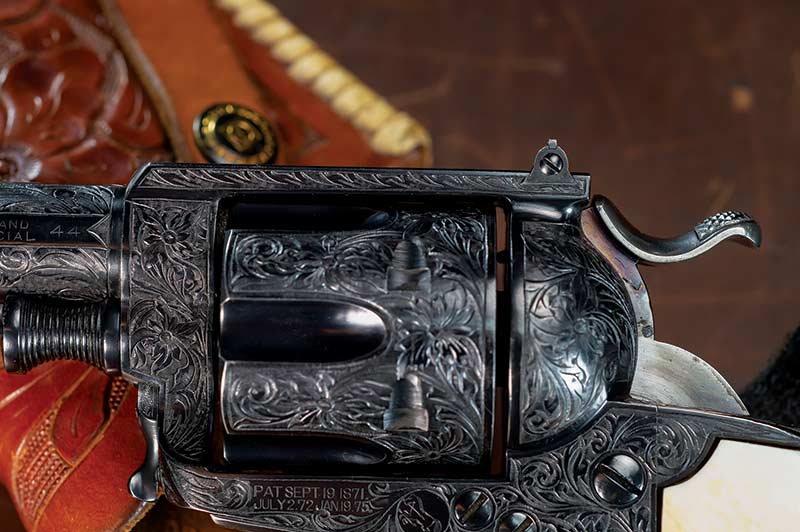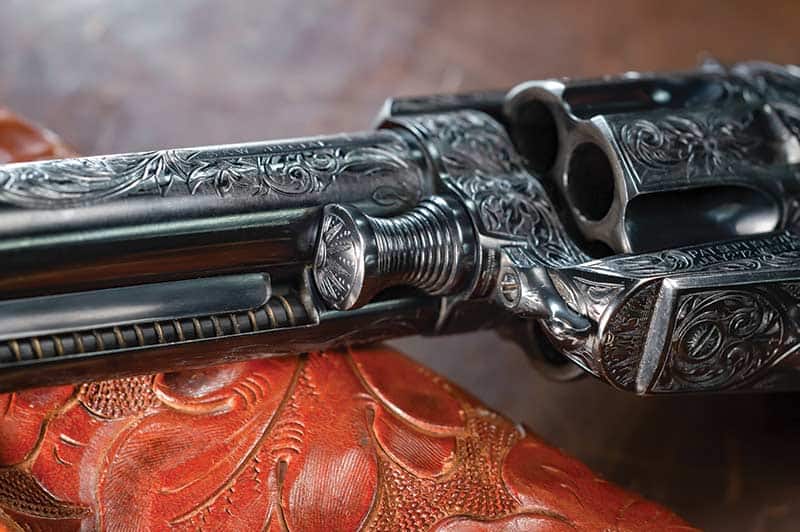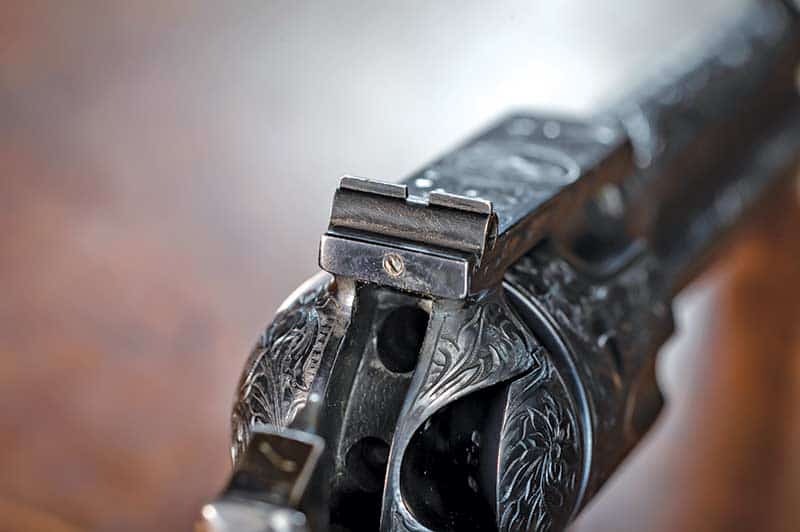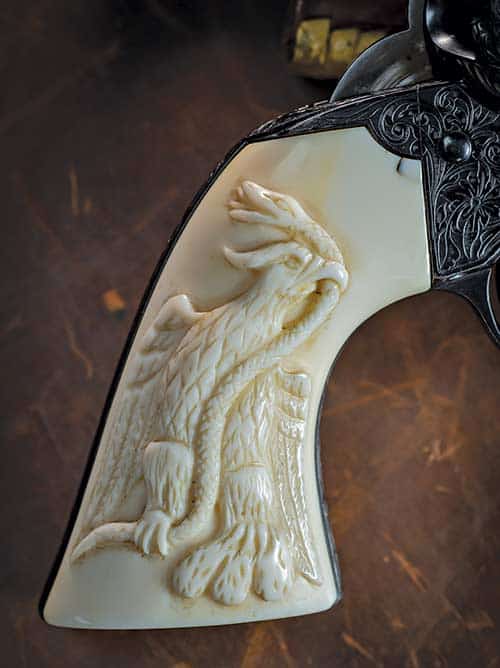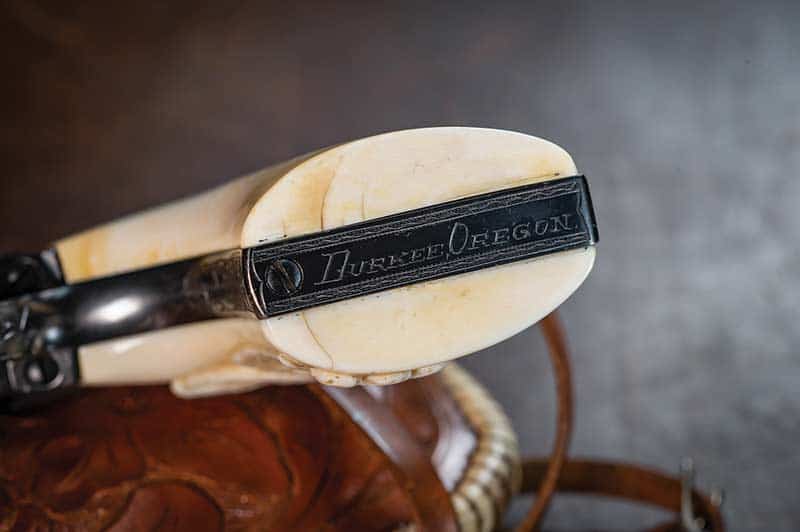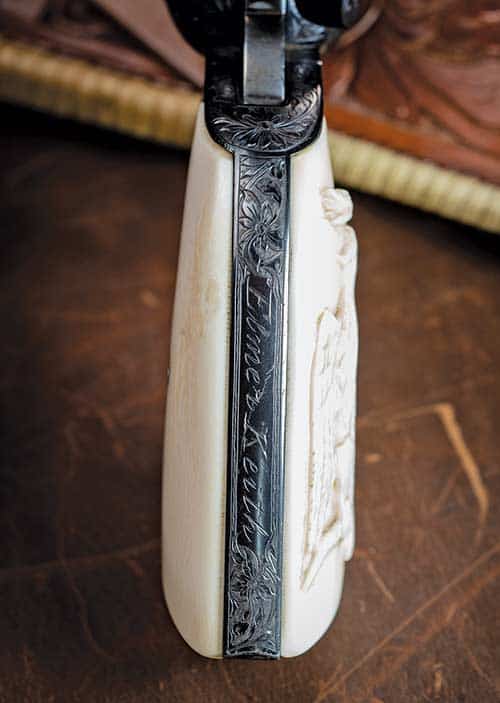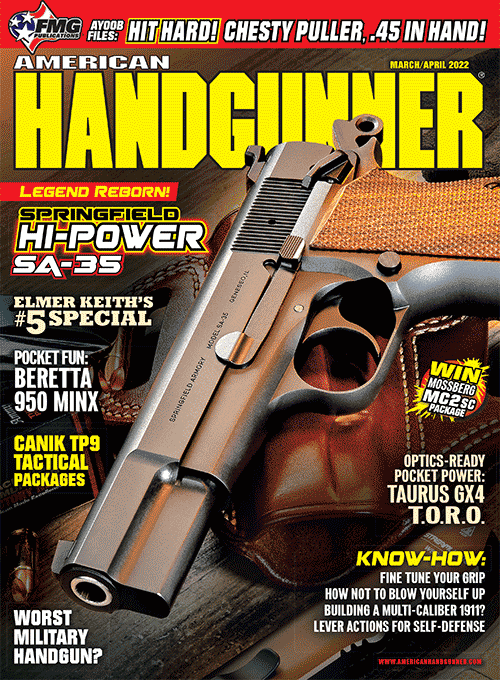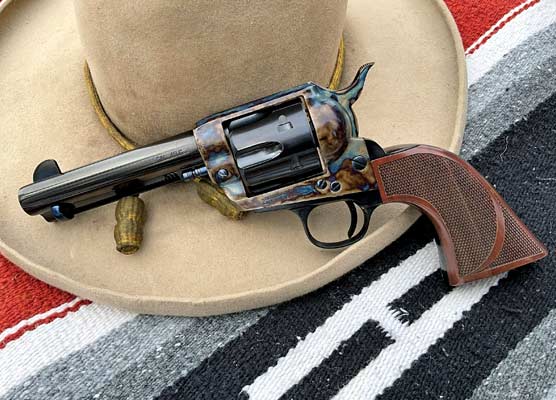The Keith #5
Single-Action Revolver
I well remember my first visit to Idaho. Mom died a few months earlier after a courageous cancer battle. Filled with “life’s too short” sentiments, I accept an offer for an elk hunt from a man I met on the internet, Dick Thompson. I made my first handgun kill using my handload, consisting of the Lyman .45 Keith bullet on a cow elk, while making lifelong friends. I also saw the Elmer Keith Museum when it was housed in the Boise, Idaho Cabela’s.
Here, seeing Elmer’s trophies, rifles and sixguns puts everything in perspective. He is, indeed, the real deal — The Grand Old Man. The crown jewel of the display is, of course, the famous #5. With nose and hands pressed flat against the glass, like a hungry kid staring in a bakery window, I think, “Boy, if I could just hold that gun!”
I imagine wrapping my fingers around the ivory stocks, the Mexican Eagle forming a natural palm-swell. I fantasize about cocking the hammer, feeling and hearing each of four distinct clicks, as Elmer did, thousands of times. Holding the very gun Elmer carried and shot for 30 years would indeed have been special — if only possible. Little do I know, 12 years later, I’d get the opportunity …
An Invite
Imagine my surprise when I’m invited to Brownells to get a chance to see and hold the iconic piece. Yes, iconic is overused, but proper, when one mentions the #5. Brownells photographer/videographer Matthew Peake invited friends Bobby Tyler, Doc Barranti and me for the occasion. The #5 was being auctioned off again by Rock Island Auction Co. and Matthew was going to be filming a few videos about the gun to stir up interest.
The #5
Imitation is surely the highest form of flattery. I’d venture to say the #5 is the most copied, imitated, sought after, and the basis for custom single-action sixguns. Just as it’s popular to say “Keith” bullet, referring to a semi-wadcutter slug with equal-sized driving bands and square grease-groove, a #5 sixgun has its own traits. The sexy grip-frame is the most obvious, being like no other. How the #5 came about is a wonderful story worth repeating, especially for those who’ve never heard it.
The Beginning
Back in 1927, Elmer Keith was writing for American Rifleman. He talked of long-range sixgun shooting at distances many thought preposterous. Harold Croft, a fellow sixgun enthusiast from Philadelphia, Pa. was intrigued by Elmer’s claims. They communicated via mail, with Elmer inviting Croft to his Durkee, Ore. ranch for a month.
Croft accepted, bringing a “suitcase full of guns” as Elmer described it. Upon arrival, Elmer nailed some boards together, making a 4’x4′ target and sets it a measured 700 yards away. Using his sitting “Keith” position, hands locked between his knees, head resting on his saddle, Elmer started shooting, hitting the target with every gun Croft brought. Keith even hit the board with a 2″ slip-gun. Croft became a true believer.
Croft spent much time and money improving standard Colt SAAs, looking to develop lightweight weapons for self-defense. He designed four different featherweight models from SA Army and Bisley Colts, calling them #1 through #4. Elmer regarded Croft’s #3 grip as perfect, considering it “the finest ever put on a sixgun.” Consisting of a Bisley backstrap mated with an SAA guard and front strap, the Bisley back strap was bent to the same angle as the SAA front strap and guard.
Excited, Elmer sent a Colt back with Croft, “to be worked over” explaining what traits he wanted from Croft’s guns, along with a few of his own ideas. Elmer said he wants the #3 grip-frame, along with target front and rear sights. He wanted the gun to be left full weight, not reduced, for better balance.
Besides the grip from Croft’s #3 gun, the Base Pin Locking Latch is the second most recognized custom feature on the #5. R.F. Sedgley designed the mechanism, which positively locks the base pin in place, making it impossible to “jump” from recoil. A swinging latch mounted on the frame fit into a square groove of the base pin. Elmer also wanted an oversized base pin head for easy removal in the field.
Building The #5
Croft has Sedgley, a master gunsmith from Philadelphia, weld-up the frame into a flat top, extending it over the hammer top, maximizing sight radius. Sedgley welded the #3 grip for Elmer’s gun and made and fit a new “V” mainspring designed by him and Croft. This new spring was less prone to breakage, while being more sensitive and quicker than standard SAA flat springs.
Elmer stated, “the gun cocks as easily as when a Newman’s ‘far country’ spring is used. The Croft-Sedgley spring is without a doubt the fastest in action of any SAA spring and should improve the SA greatly for target shooting.”
The hammer was previously made by J.D. O’Meara, by fitting a Bisley hammer top/spur to the lower of an SAA hammer, then dovetailing and brazing them together.
Sights
Elmer wanted adjustable, rugged sights on his gun. The front sight consists of cutting the last inch off a Colt Target Model barrel and reaming the cut portion, so it fits on the turned-down end of the #5 barrel, like a sleeve. The sleeve is sweated and pinned, like an S&W barrel, for added security. It’s also reversed from the Target Model, maximizing sight radius.
Elmer also wanted the rear sight dovetailed, making it windage adjustable. He requested a screw be added to the rear of the flat top frame to lock the sight in place. Elmer obviously wanted a gun capable of withstanding rugged conditions while hunting, ranching and traveling, without worrying about his sights being knocked off zero.
Croft procured Sedgley to make a wider trigger to Elmer’s specifications, instead of the typical narrow triggers placed on the left side of the guard of SAAs. Elmer said, “the trigger follows the contours of his finger and is set back, close to the guard, allowing one to properly squeeze the trigger.” Trigger pull is set at 3.5 lbs. Elmer stated, “for general excellence of grip, balance, sights, trigger and hammer, I do not think this gun can be improved upon.”
Personally Handling #5
When picking up Elmer’s #5, the first thing noticed is the deceptive lightness of the gun. You’d think it would be heavier. This is due in part to the balance of the gun and shape of the gripframe. It is a natural pointer, with sight alignment being instantaneous. The square notched rear sight is just large enough to fill the patridge style, adjustable front sight. It is genius in design, for if daylight is seen on either side, you know sight alignment is off.
The barrel and recoil shield on this gun are immaculate. Rifling is sharp with no throat erosion. We know the gun has been re-blued at least three times from Elmer’s writings. It was not engraved until later. Doc O’Meara originally made Walrus ivory stocks for it, but they were replaced when they shrunk.
Elmer had his gun engraved not to be fancy, but rather, to cover up, or conceal, the numerous scuffs and scraps it would endure from daily use. Elmer stated, “I killed 59 magpies, around two dozen crows and hawks, six horned owls, and a bobcat, to say nothing of over a hundred blacktail jack rabbits and a few woodchucks. It does excellent work at long range.”
Speaking of accuracy, Elmer said, “using a charge of five grains of Bullseye and 250-grain cast bullet, sized to 0.431″, I put five shots under a silver dollar at 15 yards. Such accuracy is good for me and will get meat when I need it.”
Closer Examination
It should be noted cylinder throats measured 0.432″ with pin gauges and gun weight is 2.55 lbs. Barrel/cylinder gap is very tight, with barely any light able to peek through. Gunsmith Bobby Tyler removed the grips, revealing the mainspring. It appears brand-new, without any hint of rust. Tyler was impressed with the complexity of the design and fitting of the spring. Barrel length was measured at 5.51″.
In Summation
The modifications requested by Elmer on the #5 display his striving to improve what was available at the time. This is evident of not only sixguns, but his cast bullet designs, handloads, or other modifications to equipment of his time. When reminiscing about Elmer, it’s something I always think about, the need to improve. Never be satisfied with what’s available. There’s always room for improvement. If not, such guns as the #5, and the many custom guns that followed it, would never have been built.
Elmer exclaimed the virtues of the #5 in an article he titled, “The Last Word” in American Rifleman. Little did he know he was just getting the conversation started on custom sixguns.

